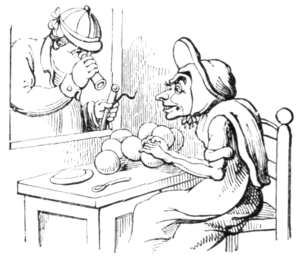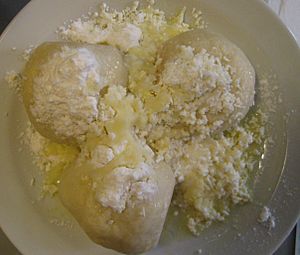Apple dumpling facts for kids

An apple dumpling served with vanilla ice cream
|
|
| Type | Pastry |
|---|---|
| Course | Breakfast, main dish, dessert |
| Main ingredients | Dough, apples, cinnamon, sugar, sometimes dried fruit and spices |
An apple dumpling is a delicious treat made by wrapping an apple in a pastry. It can be baked in an oven or boiled.
To make an apple dumpling, you first peel and remove the core from an apple. Sometimes, the apple is also cut into quarters. This apple piece is then placed on a piece of dough. The hole where the core was often gets filled with tasty things like cinnamon, butter, and sugar. Sometimes, dried fruits like raisins or sultanas are added too.
Next, the dough is folded around the apple and sealed up. Often, a sweet, spiced sauce is poured over the dumplings before they are baked. This sauce, made from sugar and butter, becomes wonderfully sweet as it bakes. Apple dumplings can be enjoyed warm, cold, or at room temperature. They are great for breakfast, as a dessert, or even as a main meal!
Contents
The History of Apple Dumplings
Apple dumplings have been around for a very long time! They were one of the earliest fruit puddings. People from all walks of life enjoyed them.
In the 1700s, apple dumplings were quite common. For example, in 1747, two recipes for apple dumplings were printed in a famous cookbook by Hannah Glasse. A botanist named Pehr Kalm traveled in America around 1749 and said he ate apple dumplings at every meal! Farmers in England also ate them often, along with bacon.
There's even an old drawing from the late 1700s called Lesson in apple dumplings. It shows a woman making them while a man watches. Later, in 1879, the famous American writer Mark Twain said that baked apple dumplings were one of the best American foods, better than anything in European hotels!
Did you know that apple dumplings were Thomas Edison's favorite food? He was the inventor of the light bulb and many other things! Even slaves in Virginia enjoyed apple dumplings at their special Fourth of July celebrations in the 1800s.
Historians think apple dumplings became popular in the United States because apples grew well there. Also, apples could be dried and used all year round. Plus, they were a practical, individual serving of food.
How Are Apple Dumplings Made?
Apple dumplings are usually made by wrapping a pastry crust around a peeled and cored apple. Sometimes, the apple is cut into quarters first. The hollow part of the apple is often filled with butter, sugar, and sometimes dried fruits like raisins. Spices are added too. The pastry is then sealed around the apple.
In older recipes, dumplings were often boiled because not many homes had ovens. But today, most recipes call for baking them. A spiced sauce is usually poured over the dumplings before they go into the oven. This sauce is often made from sugar, brown sugar, and butter, boiled with water. Sometimes, sliced lemons or spices like cinnamon are added for extra flavor.
- Preparation of baked dumplings
- Preparation of boiled dumplings
How to Serve Apple Dumplings
Apple dumplings can be served for breakfast, as a side dish, or as a dessert. They taste great hot, warm, or at room temperature. People often enjoy them with milk, cream, whipped cream, custard, or ice cream. Each dumpling is usually one serving.
Apple Dumplings Around the World
Austria
In Austria, there's a large, soft apple dumpling called apfelnockerln.
Czech Republic
Fruit dumplings, including apple ones, are very popular in Czech cuisine. They are called ovocné knedlíky. People often eat them with quark or a type of cheese called tvaroh. Sometimes, they are even served as a whole meal!
Germany
In Germany, Apfelklöße are small apple puddings. The apples are cored and filled with jam or marmalade, and sometimes raisins or nuts. They are wrapped in pastry, boiled, and then topped with a sweet sauce that might have raisins, sugar, cinnamon, and wine. This dish has been known since at least 1801.
United Kingdom
In the UK, a type of pastry called suet pastry is often used for apple dumplings. Another common choice is shortcrust pastry. One traditional recipe involves filling the cored apple with brown sugar, wrapping it in suet pastry, tying it tightly in a cloth, and then boiling it.
United States
Apple dumplings are a very common food in the northeastern United States, especially in Pennsylvania. There, they are considered a "cultural staple." Many people believe this type of apple dumpling came from Hannah Glasse's cookbook. It's a popular recipe among the Pennsylvania Dutch people and is often eaten for breakfast or as a dessert. It's sometimes served with cream, whipped cream, or ice cream.
In the US, September 17 is celebrated as National Apple Dumpling Day! There are also annual apple dumpling festivals in towns like Atwood, Illinois; Stuart, Virginia; and Sinking Spring, Pennsylvania.
Similar Dishes
Other fruits can also be used to make similar dumplings. For example, plums are often used. In parts of Austria and Hungary, dumplings filled with plums are called Knödel. Slovenian and Croatian cuisines also have similar plum dumpling dishes. Czech cuisine includes dumplings filled with plums, apricots, strawberries, or blueberries. Marillenknödel are Austrian apricot dumplings popular in Graz.
Baked Apples
Baked apples are a dish that is similar to apple dumplings but without the pastry shell. Unpeeled apples are cored and filled with things like raisins, nuts, oatmeal, or other ingredients and spices. These can be served as a dessert, a side dish, or even for breakfast.
See also
 In Spanish: Dumpling de manzana para niños
In Spanish: Dumpling de manzana para niños















